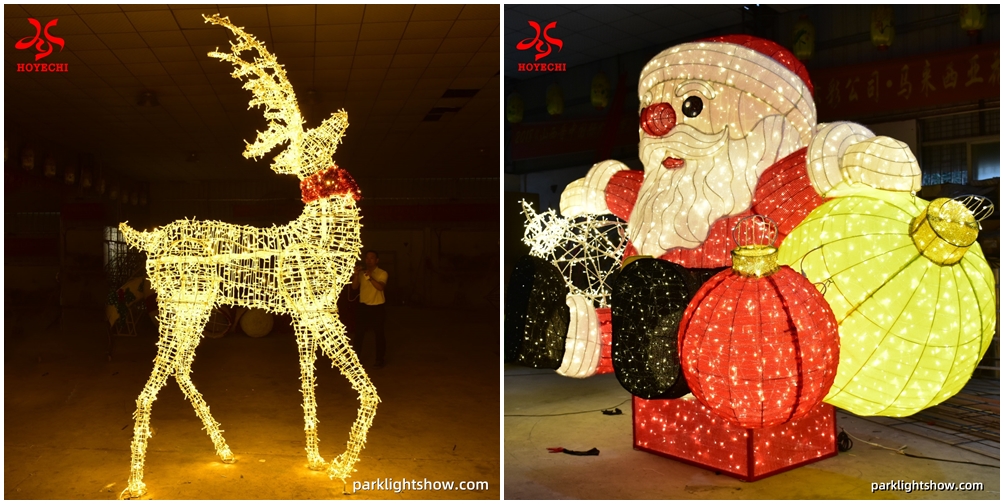How to Do a Light Show for Christmas: 8 Must-Have Large-Scale Decorations
If you’re planning a commercial holiday attraction and wondering how to do a light show for Christmas, selecting the right centerpiece decorations is just as critical as planning your lighting sequences. These installations not only shape the visual identity of your event but also influence crowd engagement, photo appeal, and overall atmosphere. Below are eight of the most essential large-scale Christmas decorations used in professional light shows—each with its unique function and visual impact.
1. Giant Christmas Tree Installation
The giant Christmas tree remains the iconic centerpiece of any holiday light show. Typically placed at the entrance or center of the venue, it is constructed with a steel frame wrapped in LED string lights, capable of dynamic color shifts and animated twinkling effects. Some trees include interior walkways, spiral staircases, or programmable light shows that invite guests to interact from within. A giant tree installation creates a visual anchor and a strong first impression.
2. Santa Claus & Reindeer Sleigh
This 3D light sculpture features Santa riding his sleigh led by reindeer and is often designed with moving parts, such as nodding heads or flying poses. Built with welded steel and coated fabric, it’s illuminated with full-spectrum LEDs. Perfect for middle sections of the light route, this piece is especially popular with families and serves as a high-value photo backdrop. It also helps convey the classic holiday narrative visually.
3. Giant Light-Up Gift Boxes
Oversized gift box installations bring playful energy to your light show layout. These pieces are often grouped in clusters or stacked into glowing “gift towers.” Made from iron frames and illuminated fabric or acrylic panels, they can be programmed with color-changing RGB light strips. Commonly placed in candyland zones, commercial areas, or near product booths, they attract both children and brand sponsorships.
4. Christmas Light Tunnel
Light tunnels are immersive walk-through experiences that connect different parts of your venue while amplifying the emotional build-up. Using a curved metal structure and synced LED strips, tunnels can be programmed to respond to music or crowd movement. Popular dimensions range from 10 to 60 meters in length. These tunnels become viral photo and video spots, often doubling as transitions between thematic zones.
5. Ice Castle & Snowman Group
For shows featuring winter fantasy themes, ice castles and snowman groupings are signature elements. Using translucent acrylic, cold white LEDs, and steel frame silhouettes, designers recreate the shimmer of ice and snow. Ice castles often include turrets, archways, and internal lighting scenes, while snowmen feature cheerful faces and accessories. These pieces are typically installed in fairy tale zones or kids’ corners, offering visual softness and charm.
6. Christmas Stars & Snowflakes
As atmospheric fillers or overhead decor, large snowflakes and star-shaped lanterns are essential for layering vertical space. Suspended from arches, roofs, or above streets, these motifs create visual rhythm across the venue. Some are motorized to rotate gently; others are programmed to twinkle or flash in rhythm with background music. They also work well for decorating facades, ceilings, or building outlines in urban displays.
7. Christmas Elves & Animal Motifs
To appeal to younger visitors and create whimsical moments, light sculptures of Christmas elves, baby reindeer, polar bears, or penguins add color and joy. These figures are usually cartoon-styled, animated, and sized for child-friendly interaction. Installed near playgrounds, activity areas, or along walking trails, they help balance the scale of larger installations while promoting multi-generational engagement.
8. Musical Light Stage
For more advanced shows, a dedicated light theater or musical stage elevates your production value. This area typically includes a small stage, synchronized lighting backdrop, and a broadcast system for narration or music shows. Designed to run scheduled performances (e.g., “The Christmas Night Adventure”), it turns static displays into emotional storytelling zones and encourages repeat visits during the season.
By thoughtfully selecting and integrating these eight elements, you’ll gain both functional structure and rich visual storytelling in your Christmas event. Understanding how to do a light show for Christmas means knowing not just where to place lights—but how to shape a complete world for your visitors to explore.
Post time: Jul-15-2025





